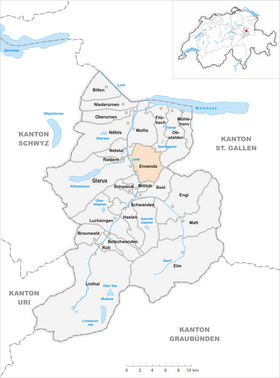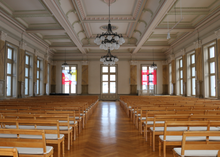Ennenda
| Ennenda | ||
|---|---|---|
| State : |
|
|
| Canton : |
|
|
| District : | No district division | |
| Political community : | Glarus | |
| Postal code : | 8755 | |
| former BFS no. : | 1607 | |
| Coordinates : | 724.58 thousand / 210505 | |
| Height : | 478 m above sea level M. | |
| Area : | 22.24 km² | |
| Residents: | 2726 (01/01/2017) | |
| Population density : | 123 inhabitants per km² | |
| map | ||
|
|
||

Ennenda is a former political municipality in the canton of Glarus in Switzerland .
The village was merged with the communities of Glarus , Netstal and Riedern to form the new community of Glarus on January 1, 2011 as part of the Glarus community reform .
coat of arms
The rod of Mercury in the upper right corner of the coat of arms is, among other things, a symbol of the wealth and international trade in textiles and slate that Ennenda enjoyed over the past centuries. It also symbolizes wealth and health. The white wavy line running across the coat of arms is a symbol of the Linth that separates Glarus from Ennenda. In the lower left corner there are black and yellow stripes in the colors of the Glarus (City of Glarus) coat of arms. The coat of arms of the municipality of Glarus (after the municipality merger) is strongly influenced by the Ennendan coat of arms.
Today's Ennendas coat of arms was only introduced in the 1930s.
geography
Ennenda reaches from the lowest point at 462 m above sea level. M., the Alpenbrückli , up to the Hächlenstock at 2316 m above sea level. M., the highest point in the municipality. It consists of the parts of the village Oberdorf, Sturmigen, Ennetbühls and Ennetberge. The community is located opposite Glarus on the right-hand eastern side of the Linth at the foot of the Schilt. Of the community area, 35.5% is agricultural land, 37.7% is forest, 3.8% is settlement area and 22.9% is unproductive.
population
| Population development | |
|---|---|
| year | Residents |
| 1554 | 204 |
| 1763 | 1,018 |
| 1850 | 2,313 |
| 1870 | 2,783 |
| 1900 | 2,494 |
| 1950 | 2,940 |
| 1960 | 3,076 |
| 2000 | 2,808 |
| 2010 | 2,684 |
| 2017 | 2,726 |
politics
The SP received 71.1% of the vote in the 2003 National Council elections, and 28.9% of the votes went to other parties. This result is only of limited informative value, since the previous SP representative was very popular as a person and the largest Glarus party, the FDP , did not run (in return, the SP waived a candidate for the Council of States ).
The composition of the nine-member municipal council (elected by Majorz) is even more meaningful, as of the last elections in 2006: 4 FDP, 3 SVP, 2 SP (including the mayor Käthi Meier-Probst). Since then, 1 SP and 1 FDP municipal council has resigned; In view of the imminent merger with Glarus, Riedern and Netstal, which will mean the dissolution of the municipality of Ennenda and its municipal council, these two seats will no longer be filled.
history
The first time Ennenda (then still: "Obront and Nydern Ennent-A") was mentioned in the land register of the Habsburgs and Säckingers in the 14th century. This also explains the name of the community: Ennet-A, i.e. Beside the River (Ennet em River).
The oldest part of the village, the upper village , is mentioned 1303–1307 as Obront-Ennant-A and the Niederdorf Nydern-Ennant-A . In 1395 the village had to be paid by the Säckingen monastery . The residents of Glarus were church-related. The Reformation was introduced in 1528. In 1774 the reformed church was built in Ennenda, and a year later the rectory.
The use of water power by mills, saws, hemp and flax pounders has been documented since 1417. The level valley floor could already be used in the 16th century after the Linth was dammed.
Jakob Bellersheim from Hessen began making slate tables in 1616. This trade experienced such a boom that from the middle of the 17th century to the middle of the 18th century most households were involved in the manufacture and export of the slate tables. Ennenda developed into a trading village and important companies of the old Swiss Confederation had their headquarters here, for example the Viennese dealership Jenny-Aebli & Comp., The German dealership of Markus Oertli & Sohn in Riga and the Dutch trading company Weber-Aebli & Comp. These companies were active all over Europe at the time.
In 1774 the Reformed Church Ennenda was built. The rectory in 1775. Before that, the Ennendans went to Glarus for church services. After a heavy snowstorm at Christmas and New Year 1773 prevented the Ennendans from attending the church service without difficulty, the decision was made in January to build their own church - probably also for the reason that it is simply easier to go to church in your own village to go and to maintain a community in their own village. Over the years, the Ennendans must have received such a need for their own house of God, with which they can also identify, that they began building the church on the same evening of the meeting - in the same year as the completion. The opening of the church marks the complete, since 1774 also socio-religious, declaration of independence to Glarus.
After the downfall of the trading houses, textile printing and other branches of industry found their way into Ennenda. Ennendaner also invested diligently in other villages and communities. Most of the industries in the other municipalities of the canton have been in the hands of an Ennendan at least once. In addition, many arable land / forest areas were leased or bought in other communities. Many parts of the Klöntal were effectively in Ennenda's hands.
The canton's first schoolhouse was inaugurated in 1832. Ennenda was a pioneer village in many areas. In addition to the first educational institution, Ennendans were leaders in the implementation of the Glarus Factory Act, as well as the creation of a welfare system.
Thanks to a flourishing and experienced industry, Ennenda became one of the richest, even the richest communities in Switzerland at the end of the 19th century. This can be seen in the magnificent, palatial parish hall and in Villastrasse. The wealth also manifests itself in the fact that there was no income tax around 1900. The bills were taken over by the factories and their masters - even for the poor.
In 1879, as part of the opening of the railway line between Glarus and Linthal, a three-track station was built in Ennenda, which has since been reduced to one track.
The Läderach company , which produces pralines and confectionery, is based in Ennenda.
Ennenda parish hall
The "metropolitan" building of the Ennenda parish hall, in the style of neo-renaissance architecture of historicism, was built in 1889–1890 by the architects Jacques Kehrer and Karl Knell. With buildings such as the Conservatory in Zurich and the villas on Villastrasse, her name became known throughout Switzerland. The plans for the community center project include plans that come from the pens of well-known architects from London and Germany. Alexander Koch , the builder of the Hirschengraben or Villa Egli schoolhouse, also submitted a project plan with his pompous, neo-Gothic proposal and came in second. There were a total of 31 submissions. At the corresponding meeting, the Ennendans decided on one of the most expensive options, the cost of which at the time was CHF 180,000. The formal language of the parish hall corresponds to a strict and somewhat dry language of the Neo-Renaissance and also houses elements of the French palace construction.
The new Glarner Zeitung wrote at the opening on November 1st, 1890: " So Ennenda has built a community hall, which not only serves the community, but also the country as an honor and ornament, because it is not only the most beautiful community hall, but itself competes with the state buildings of the main town. We would almost like to wish that one day the community of Glarus will also have buildings [...] that are just as artful. In the meantime, we wish Ennenda luck with the finished work, we are pleased with his progress and hope that the Resolutions, which are taken in the new hall, are worthy of the blossoming community! "In a publication of the 21st century, what the Neue Glarner Zeitung wrote about the opening of the parish hall was confirmed, because in it the spirit of Ennendas is manifested - initiative , Work and wealth.
In addition, Jürg Davatz wrote in the Glarus art monuments inventory on June 26, 1979: " The Ennenda parish hall is of exemplary importance far beyond the canton's borders: the up-and-coming industrial community at that time documented its self-confidence with a community palace with urban allure. The competition projects also prove that the The community, which had around 2400 inhabitants at the time and had a hall built for around 1000 people, speaks for itself. At the inauguration, one could see with satisfaction that the hall in the Glarus rifle and community center had been considerably surpassed. "
In 1984 and 2007 the parish hall was generously renovated.
traffic
Ennenda is served every hour by the S6 of the S-Bahn St.Gallen, the S25 of the S-Bahn Zurich and the bus line 503 (Ennenda, Seilbahn - Glarus, Pfrundhaus).
Personalities
- Peter Atteslander (1926–2016), sociologist
- Bernhard Becker (1819–1879), Protestant clergyman and social politician
- Giacomo Bernasconi (1905–1972), Basel SP Grand Council
- Remo Freuler (* 1992), football player
- Gottfried Huber-Pestalozzi (1877–1966), doctor and naturalist
- Caspar Jenny (1812–1860), National Councilor and Councilor
literature
- Karin Marti-Weissenbach: Ennenda. In: Historical Lexicon of Switzerland . October 26, 2016 , accessed December 28, 2019 .
gallery
Web links
- Ennenda on the website of the municipality of Glarus
- Karin Marti-Weissenbach: Ennenda. In: Historical Lexicon of Switzerland .
- Anna Göldi Museum in the hanging tower
Individual evidence
- ↑ Neue Glarner Nachrichten: The Ennenda parish hall . November 1, 1890.
- ↑ Linus Hofmann: The early economic history of Ennendas depicted in a painting . 2019.
- ↑ Jürg Davatz: Inquiry from the Ennenda town council regarding the renovation of the town hall . June 26, 1979.
- ^ Bernard Degen: Giacomo Bernasconi. In: Historical Lexicon of Switzerland . June 11, 2004 , accessed December 28, 2019 .
















